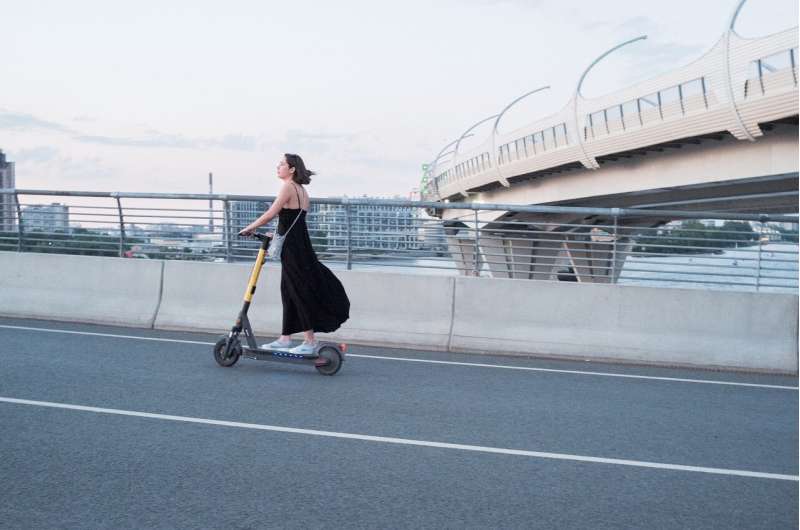This article has been reviewed according to Science X's editorial process and policies. Editors have highlighted the following attributes while ensuring the content's credibility:
fact-checked
peer-reviewed publication
trusted source
proofread
Crashing an e-scooter likely to lead to more serious injuries than crashing a bike

E-scooter riders are likely to sustain more serious injuries, particularly those of the head, than cyclists after a road traffic collision, finds an audit of recent trauma care in England and Wales, and published online in the journal Injury Prevention.
Their findings prompt the researchers to call for additional legislation and tighter regulation of e-scooter rentals to boost the safety of this increasingly popular mode of transport.
The potential for e-scooters to replace cars for short distance journeys, and help reduce greenhouse gas emissions, has fueled the rapid adoption of e-scooter rental trials globally, the first of which began in the U.S. in 2017.
In the U.K., public use of e-scooters is permitted only as part of rental trials, although privately owned e-scooters are widely used. The U.K. e-scooter rental trial began in July 2020 and has now expanded to include 57 locations including London.
Eligibility criteria for rental require riders to be over 17 and to hold a minimum of a provisional driving license. It's illegal to operate an e-scooter while drunk or high.
Before the rental trial started, the U.K. government ran a public consultation, which resulted in the relaxation of proposed regulations for the trial, explain the researchers. Helmet use was made voluntary; maximum power was raised from 350 W to 500 W; and maximum permitted speed was raised to 15.5 mph from 12.5 mph.
The bulk of the evidence to date on e-scooter injuries consists of single center or citywide case series of emergency department visits, detailing relatively minor trauma, say the researchers.
To provide a more detailed and comprehensive analysis of e-scooter injuries, and compare them with those sustained by cyclists, the researchers drew on information supplied to the UK Trauma Audit and Research Network (TARN) registry by trauma centers and hospital trauma units in England and Wales for the 12 months of 2021.
The researchers wanted to find out if there were any differences in injury patterns, treatment, and potentially influential background factors between the two groups.
Throughout 2021, 293 e-scooter riders and 2538 cyclists were admitted to hospital after a road traffic collision in England and Wales.
E-scooter riders were more likely to be admitted to a major trauma center or a critical care unit than cyclists: 60% vs. 47%.
Injured riders were predominantly male in both groups, but injured e-scooter riders tended to be younger, with an average age of 35 vs. 50. Almost a sixth (14%) were aged 16 or under compared with only 8.5% of cyclists.
E-scooter riders were almost three times as likely as cyclists to be drunk or high (26% vs. 7%) at the time of the incident and less likely to have worn a helmet (7% vs. 47%). And they were twice as likely as cyclists to sustain their injuries between 6 pm and midnight.
Analysis of injury patterns showed that trauma involving the head and arms/legs were the most common causes of serious e-scooter injury and they were more common than in cyclists: 35% vs. 20% for head injuries; 40% vs. 27% for leg/arm injuries. Serious chest injuries were more common among cyclists: 32.5% vs. 17%.
Almost twice the number of e-scooter riders had the most severe head injuries (28% vs. 15%) while double the number of cyclists had the most severe chest injuries (5% vs. 11%). Thirty-seven out of the 41 critical injuries (90%) among the e-scooter riders were head injuries.
Death was rare among both groups: less than 3% for e-scooter riders and less than 2% for cyclists. But significantly more e-scooter riders required critical care (20% vs. 15%).
More than four fifths of both groups of patients were discharged home and while the absolute numbers were small, the rate of transfer for rehab for cyclists was double that for e-scooter riders (5.5% vs. 2.5%).
While the overall rate of significant injury among cyclists was 9 times higher than it was among e-scooter riders, bicycle use in the U.K. is likely to be at least 9 times greater than e-scooter use, point out the researchers. "Therefore, it is possible that e-scooters are resulting in higher rates of trauma than bicycles," they suggest.
They point out that their study didn't take account of injuries to pedestrians or other road users, added to which only patients admitted to hospital are included in the TARN database, so the true impact of injury from e-scooters may be even greater.
"E-scooters are an emerging mode of transport in the U.K., and full characterization of rates and types of injury will require ongoing study," write the researchers.
"However, these preliminary results indicate that [their] use may result in a higher relative rate of hospital admission due to significant trauma than bicycles and in particular, higher rates of severe head injury," they add.
And they conclude, "As the number of e-scooter trips taken continues to grow, further legislation and tighter regulation of e-scooter rental are required to reduce the already significant burden of injury associated with this mode of transport."
More information: Richard Alexander Clough et al, Major trauma among E-Scooter and bicycle users: a nationwide cohort study, Injury Prevention (2023). DOI: 10.1136/ip-2022-044722


















